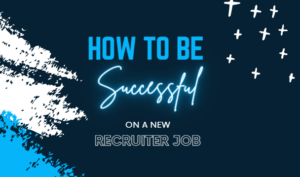
Starting a new Recruiter job can be exciting and stressful all at the same time. You will want to hit the ground running starting on day one. You will be meeting and connecting with the whole business right away. It will be good to create a plan and set some goals that you will want to hit within the first 30 to 60 days.
I remember starting at my first inhouse talent acquisition job as a full-time Talent Sourcer. I was so excited to hit the ground running on the first day. In some ways, I felt new and uncertain of my sourcing abilities. I wanted to impress my new manager and wanted to meet all the hiring managers. I made small mistakes and handled obstacles well. I wish management would have created an onboarding roadmap for my long-term success. A lot of the learning process was really completely up to me and my judgement. I was there to sink or swim and unfortunately wasn’t given the best onboarding experience. Thankfully, you can learn from my mistakes and hopefully learn something from my advice. Below I’ve created a solid roadmap plan for any Recruiter starting on a new inhouse talent acquisition team.
Here’s how to be successful on a new Recruiting Team:

1. Make a List of Connections
As you meet people through the halls or at team meetings. Make a list of people that you want to connect with further. Learn how the company works and connect with every possible team member. Try and understand the culture and environment right away. To make a good impression memorize names and other unique facts about people. Ask to go out to lunch or have a coffee chat – don’t worry it won’t need to be that formal. Just quick touchpoints to connect with others. Being remote now this has changed for most people. So, make an effort to message and set up Zoom chats when possible. Ask a ton of questions try and make an effort to showcase your interest. Remember, you’ll be selling the team and projects to potential applicants in the future.
2. Learn about the Company’s Recruiting Process
Connect with your manager and meet with every team member right away. Understand the process of how they bring applicants through the recruiting lifecycle. Each company will do things differently. Understand which ATS and CRM system they use and why. Also, take the time to understand HR compliance and other important factors within their process. Come prepared to ask a ton of questions and don’t be afraid to schedule a follow up meeting.
3. Connect with Hiring Managers and have Intake Meetings
You will need to understand the company’s needs and objective for yearly hiring goals. Set up meetings with each hiring manager to talk over open requisitions. Come prepared with a list of intake questions. I’ve written some intake examples (here). Have them walk through what types of applicants that they will want to see and why. Ask for updates on roles and what struggles they’ve faced before you started. Try and understand the problems that they are facing and present how you can solve them. Building long term relationships with hiring managers will be very important.
4. Set Goals and Track Recruiting Metrics
Track every part of your sourcing and recruiting process. I have an excel document that I track every single day. I want to know how many applicants I’m screening and how many submittals I’m making every week. Your manager will probably leave this up to you for how you want to track this. I’d say create an excel sourcing tracker sheet right away. You can then present this data to your manager and hiring managers within your first 30-60 days. Always, make an effort to showcase your ROI. Present this data and showcase that if they used outside agencies, they would be spending a ton of money. I’ve written a post about tracking recruiting metrics (here).
5. Understand the Company’s Goals and Objectives
What’s the core reason for the job opening? Why are the requisitions open in the first place? Understand the main reason for the openings and how you can present this to applicants. Say we’re building a new project or service within the company? Give applicants a reason to get excited. Talk about your employer brand and culture.
6. Keep Learning
I always recommend continuous learning. You will always be a student as a Recruiter. Take courses to understand niche skill sets and talk with hiring managers. Become an expert in the roles that you are recruiting and sourcing for. It will take a lot of time and effort but in the end, it will pay off. You will become known as Recruiter locally and applicants will start to network with you directly. Build connections and keep learning! I wrote a post about advancing your sourcing knowledge (here).
Recommended Reading:
HIRETUAL AI Sourcing Tool Review
How to Advance your Talent Sourcing Skills
Will Talent Sourcing Become Automated within the Next Decade?
- AI Search Will Transform Talent Sourcing Forever - January 10, 2025
- Build an AI Sourcing Assistant using ChatGPT 4 - January 10, 2025
- Top Recruiting Leaders to Follow in 2025 - January 8, 2025
